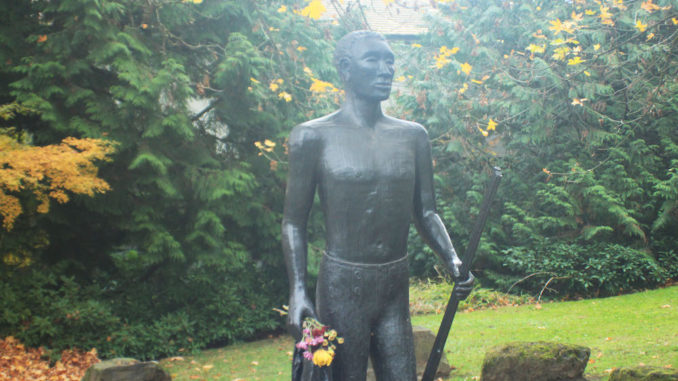
By Ihsaan Mohamed
When Alison Saar first heard the open call for artists to submit their ideas for a sculpture at Lewis & Clark College, she was a bit wary. The statue was supposed to honor York, the African-American slave who played a huge role in the Lewis and Clark expedition. It’s not that Saar, a famous mixed-media artist whose most prominent works include a monument honoring Harriet Tubman located in NYC, was uncomfortable with the topic. It was that she wasn’t sure if her vision for York would match what the college wanted.
“I’m not a portrait artist,” Saar said via FaceTime. “And I was not interested in heroizing York or whitewashing history.” Monuments that celebrate minority figures often glamorize them and whitewash the brutal history behind them. Saar had seen this happen often, and predicted that LC would follow this example. However, the art director at LC, Linda Tesner, was familiar with Saar’s work and personally called her and asked her to submit. And to her delight, Saar’s proposal ended up winning the commission for the monument.
Saar was born into a family of artists and had been surrounded by art her whole life.
“My mother is an artist, and so is my father, and at first I shied away from art because I was living in such a huge shadow,” she said. Eventually, she realized that art was one of the only things she was good at. “I decided to succumb to the art.”
Saar has been in the industry for 15 years and creates many of her pieces for the public. “My mother is always influential in my work.” Saar said. Her mother, Betye Saar, is a famed African-American artist whose work tackled racism in the 1960s. Most of her art is inspired by her identity as a biracial African-American woman. And even if those parts of her identity are not major themes, Saar still creates her art through the perspective of a woman and an African-American person.
When an artist is commissioned to create a public monument, they often have to create a narrative, which describes the artist’s ideas for piece of art, explains how it will interact with the community it resides in, and often includes lots of pictures. While this is mainly to help the artist created a detailed plan, it also makes sure there are no surprises when the art is completed. However, before Saar could even begin to create the narrative, she had to do a lot of research. While she had learned about the Lewis and Clark expedition in history classes, they had glossed over York and focused more on the role of Sacagawea. The research she did on York really impacted how Saar depicted him in the statue.
“York was the only member of the expedition who was not monetarily compensated,” Saar said. “And I wanted to reveal his status, that he was still a slave.” Saar was not interested in glamorizing his strength and wisdom, or glossing over the fact the he was still a slave and remained a slave even after the expedition. Located on the path next to the Glade, York is depicted shirtless with the map that Lewis and Clark traveled inscribed into his back, and a musket in one hand. While he was trusted with protecting the group and even had a say in where they would stay, he was still a slave and was burdened by the oppression of his master. Saar worked with caste bronze because of its resistance to weathering. She also depicted York without any specific features that would tie him to a certain figure in history.
“I wanted to give him a face, but there are no images of York,” Saar said. “To be hyper-realistic I gave him generally accurate African-American features.” This was to make sure that if any more information was released in the future, the monument would not be historically inaccurate.
All in all, the statue took a little over a year to complete. This was less time than statues might typically take, mostly because York’s statue was so short.
To this day, Saar’s favorite part about this monument and her other works of art are how people interact with it.
“I know it’s just college antics,” Saar laughed. “But I know people put raincoats and flowers on York, and I like it because it means they’ve accepted him into their community.”
Subscribe to the Mossy Log Newsletter
Stay up to date with the goings-on at Lewis & Clark! Get the top stories or your favorite section delivered to your inbox whenever we release a new issue.

Leave a Reply